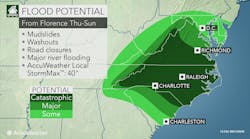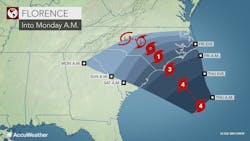While much of the focus ahead of Hurricane Florence has been on the coastal areas, weather experts are warning the Category 4 storm could bring catastrophic flooding and damaging winds to major cities well inland.
“The risk levels inland are going to be just as high as at the coast,” Jonathan Porter, vice president of business services for AccuWeather Enterprise Solutions, told Fleet Owner.
More than 1.5 million people have already evacuated from the coastal areas of South Carolina, North Carolina, and Virginia. Florence is projected to make landfall Thursday afternoon or evening near the Carolina border.
Coastal areas need to be concerned of storm surge, heavy winds, and potentially tornadoes, while Porter also stressed there is a strong possibility of the storm “stalling out for days” once it moves inland. That could result serious flooding and wind damage for cities including Raleigh and Charlotte in North Carolina, and Columbia in South Carolina.
“This storm will produce a tremendous amount of rainfall over a broad area,” said Porter, warning some projections are up to 32 inches by the end of the weekend. That could leave areas “inundated for days,” with some areas “cut off from the outside world for at least a short period of time – and perhaps days."
Freight haulers need to be prepared for many washed out roadways and damage to rail infrastructure across this multi-state area.
Ahead of the storm, the Federal Motor Carrier Safety Administration (FMCSA) issued an emergency declaration that eases regulations for truckers from many states along the East Coast providing storm assistance.
“This emergency declaration is needed to address anticipated emergency conditions in the affected states and jurisdictions creating a need for immediate transportation of supplies, equipment and persons, and provides necessary relief,” FMCSA said in its notice.
It includes transporting supplies, equipment, fuel, or people to and from the areas hit by the storm. The declaration covers Delaware, District of Columbia, Florida, Georgia, Maryland, New Jersey, New York, North Carolina, Pennsylvania, South Carolina, Virginia, and West Virginia.
Governors of several states including North and South Carolina have also waived certain trucking and transportation regulations to help prep for the storm – and be ready to take quick action once the worst it over.
With so much focus on Florence, Porter is urging people to be wary of another storm developing in the Gulf of Mexico that could bring heavy rain and flooding to east Texas. The affected area stretches from about North Brownsville to the Louisiana border, and potentially includes Houston, which is still recovering from Hurricane Harvey.
DAT Solutions reported the Labor Day holiday and the need to position freight ahead of Hurricane Florence led to an increase in spot truckload van and refrigerated freight rates during the week ended Sept. 8.
The national average spot van rate rose 6 cents to $2.20 a mile, while the reefer rate gained 8 cents to $2.57 a mile.
The hurricane is barreling down during National Truck Driver Appreciation Week. That timing was not lost on Elaine Chao, secretary of the U.S. Department of Transportation.
“When a disaster causes store shelves to empty, gas pumps to shut off and electrical grids to shut down, America’s truck drivers bring in the supplies that save lives, provide comfort and allow people to rebuild. So we should all be even more appreciative than usual this week for their hard work and professionalism. And let’s wish these men and women safe travel and help them out by operating our own vehicles in a safer manner in proximity to large trucks,” Chao wrote in a blog post.
For those still preparing for the storm, Penske Truck Leasing has put together a tip sheet. Likewise, additional storm preparation information could be found at a special site put together by the Department of Homeland Security.




